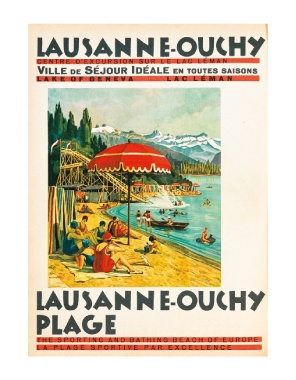Page 245 - Livre Beau Rivage Palace
P. 245
Fig. 3
foreign visitors will arrive or pass through the city, and that there will be is less well-known), architectural and urban models were exported
much more traffic […]. This movement will evidently affect the hotel out of Switzerland to redraw the landscape of northern Italy.
industry and we can predict that new hotels will be built in Lausanne itself
and in the surrounding area.’ 1. Archives du Beau-Rivage (ABR), ABR, shelf mark 046, Société Immobilière d’Ouchy, Conseil
15
On both sides of the tunnel, people were quick to grasp the d’administration: Rapport du Conseil d’Administration de la Société Immobiliaire d’Ouchy, à
l’assemblée générale ordinaire du 19.04.1909, à l’Hôtel Beau Rivage. (Report of the board
importance of the railway and the benefits to be drawn from the of directors and the Société Immobiliaire d’Ouchy to the general assembly of 19 April
1909 at the Beau-Rivage Palace).
tourism it promoted. Inspired by the example of the Lake Geneva 2. At the Montreux Palace, the builders made up for the delays caused by the strikes by
working at night and barricading themselves inside the building site to prevent the
Riviera, developers in the region of Stresa (at that time a simple unions from interfering with their work (Archives de la Société Romande d’Energie).
3. Feuille d’Avis de Montreux, Tuesday 26 March 1907
fishing village) and the Borromean Isles rapidly built a number 4. See the following references: André Lasserre, La classe ouvrière dans la société vaudoise
de 1845 à 1914, Bibliothèque historique vaudoise, Lausanne, No. 48, 1973; Feuille d’Avis
of hotels, such as the Regina Palace, which opened in 1908. The de Montreux 1907; Acom Montreux, CHD TV 14, Affaires de la grève générale.
Italian resort was so keen to emulate the success of cities like 5. See the following references: Eléonore Rinaldi, Con baffi, senza baffi. Les immigrés italiens
et le développement urbanistique de Montreux à la fin du XIX e siècle [dissertation for history
Lausanne and Montreux that it even copied the way in which they degree], UNIL-Faculté des lettres (University of Lausanne-Faculty of Arts), Lausanne,
2006; ‘La construction des hôtels de Montreux et les Italiens à la fin du XIX e siècle, in:
had organised their beaches and bathing areas. The Commune of Revue historique vaudoise (Lausanne) 114, 2006, pp. 241-252; L’apport de la main d’œuvre
italienne dans la construction de l’‘industrie touristique’ de 1880 à 1914 [ongoing
Stresa archives thus contain plans of the beach at Villeneuve, along doctoral thesis], UNIL-Faculté des lettres, Lausanne.
6. On this subject, see the many complaints from tourists who had been bothered by workers
with photographs of the lidos of Villeneuve, Vevey and Ouchy on the quays, as reported in the Feuille d’Avis de Montreux local newspaper.
7. ABR, shelf mark 046, Hôtel Beau-Rivage à Ouchy-Lausanne. Conditions particulières et
and correspondence between Italian hoteliers and those of mode de métré pour les travaux de Terrassements, Maçonneries et Pierre de Taille, article 3:
Organisation du chantier.
Lugano, Montreux and Ouchy (figs 2 and 3). 8. ABR, Procès Verbaux du Conseil d’Administration, 19 October 1905.
Although holidaymakers flocked to the shores and beaches 9. François Damien Negri was born on 5 January 1875 – but some sources give his date of
birth as 1876 or 1878 – in Agnona in the province of Novara (Italy). He later became a
of Lake Geneva, at first the board of directors of the Beau-Rivage resident of Collonges sur Territet. (Archives de Montreux, Registres de permis de séjour,
PL RA 27.)
Palace was not overly keen on the idea of creating a beach at Ouchy 10. Louis Jacques Uberti was from Borgosesia in the province of Novara (Italy) and later
became a resident of Lausanne.
to attract more tourists: ‘The opinion of all the members of the Board 11. Leïla El-Wakil, Erich Mohr, Léman 1900. Morceaux choisis d’architecture. Une poésie
monumentale [Chêne-Bourg], H. Georg, Geneva, 1994, p. 31.
is that creating a bathing establishment on the quays of Ouchy would ruin 12. Jules-Napoléon Clerc (1844-*), was originally from Mâcon in France, trained at
the view, and that we should not encourage it […]. Finally, the Board has the École des Beaux-Arts in Lyon and lived in Montreux; he notably designed the Villa
Florentine, home of Alexandre Emery.
decided to reply to the Comité de la Société de développement d’Ouchy 13. Registre du Commerce, Registre principal A, livre analytique du District de Vevey, no. 4.
14. Acom Montreux, CHD GC 634.
that we are prepared to help finance the creation of a bathing area by the 15. ABR, shelf mark 046, Rapport au Conseil d’Administration de la Société Immobilière d’Ouchy
sur la construction d’une annexe, 4 November 1903.
lake near Ouchy, but only on the condition that the establishment is not 16. ABR, Procès Verbaux du Conseil d’Administration, 2 March 1908 and 4 May 1908.
located between the Tour Haldimand and the steamboat landing stage.’ 16
Convinced that there was money to be made, the local
authorities, councillors and hoteliers of Lausanne eventually
agreed to build a beach, which the brochures of the Beau-Rivage
Palace would boast of as one of its many assets (fig. 4).
A chapter in the long history of relations between Italy and
Switzerland was thus written, in which notably, migratory patterns
responded to economic demands. It was a two-way exchange: in
one direction, cheap Italian labour flooded into Switzerland to
work in the luxury hotel industry; in the other direction (and what
Beach at Lausanne-Ouchy. Postcard, c.1932. Fig. 4
Beach at Lausanne-Ouchy, advertisement appearing on the back page
of the Gazette des étrangers/Visitors’ List [c.1930].
244

